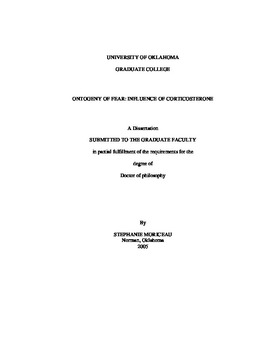| dc.contributor.advisor | Sullivan, Regina M., | en_US |
| dc.contributor.author | Moriceau, Stephanie. | en_US |
| dc.date.accessioned | 2013-08-16T12:19:54Z | |
| dc.date.available | 2013-08-16T12:19:54Z | |
| dc.date.issued | 2005 | en_US |
| dc.identifier.uri | https://hdl.handle.net/11244/914 | |
| dc.description.abstract | A strong attachment to the caregiver is critical for survival in altricial species, including humans. While some behavioral aspects of attachment have been characterized, its neurobiology has only recently received attention. Using a mammalian imprinting model, we are assessing the neural circuitry that enables infant rats to attach quickly to a caregiver, thus enhancing survival in the nest. Specifically, the hyper-functioning noradrenergic locus coeruleus (LC) enables pups to learn rapid, robust preference for the caregiver. Conversely, a hypo-functional amygdala appears to prevent the infant from learning aversions to the caregiver. Adult LC and amygdala functional emergence correlates with sensitive period termination. This work suggests the neonatal brain is not an immature version of the adult brain but is uniquely intended to optimize attachment to the caregiver. Although human attachment may not rely on identical circuitry, the work reviewed here suggests a new conceptual framework in which to explore human attachments, particularly attachments to abusive caregivers. | en_US |
| dc.format.extent | xi, 262 leaves : | en_US |
| dc.subject | Corticosterone. | en_US |
| dc.subject | Rats Training. | en_US |
| dc.subject | Biology, Neuroscience. | en_US |
| dc.subject | Attachment behavior. | en_US |
| dc.subject | Biology, Zoology. | en_US |
| dc.subject | Neurobiology. | en_US |
| dc.title | Ontogeny of fear: Influence of corticosterone. | en_US |
| dc.type | Thesis | en_US |
| dc.thesis.degree | Ph.D. | en_US |
| dc.thesis.degreeDiscipline | Department of Biology | en_US |
| dc.note | Source: Dissertation Abstracts International, Volume: 66-08, Section: B, page: 4105. | en_US |
| dc.note | Adviser: Regina M. Sullivan. | en_US |
| ou.identifier | (UMI)AAI3186961 | en_US |
| ou.group | College of Arts and Sciences::Department of Biology | |
